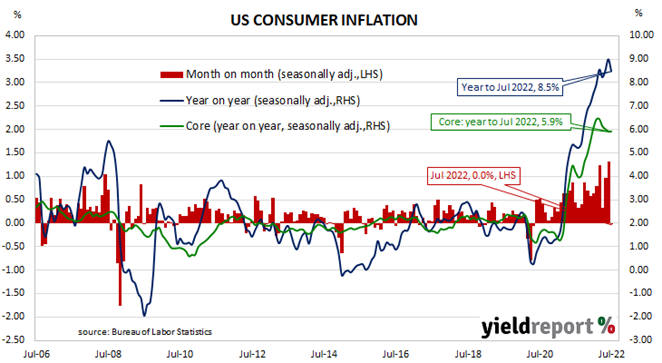Summary: US CPI unchanged in July, lower than expected; “core” rate up 0.3%; “pleasing first step” towards combatting inflation; short-term Treasury yields decline, longer-term yields up, rate rise expectations wound back; 0.3% core inflation “hardly be seen as comforting in normal times”; energy prices main driver of headline fall.
The annual rate of US inflation as measured by changes in the consumer price index (CPI) halved from nearly 3% in the period from July 2018 to February 2019. It then fluctuated in a range from 1.5% to 2.0% through 2019 before rising above 2.0% in the final months of that year. Substantially lower rates were reported from March 2020 to May 2020 and they remained below 2% until March 2021. Rates have since risen significantly.
The latest CPI figures released by the Bureau of Labor Statistics indicated seasonally-adjusted consumer prices remained unchanged on average in July. The result was lower than the generally expected figure of 0.2% as well as June’s 1.3% jump. On a 12-month basis, the inflation rate slowed from June’s reading of 9.0% to 8.5%.
“Headline” inflation is known to be volatile and so references are often made to “core” inflation for analytical purposes. The core prices index, the index which excludes the more variable food and energy components, increased by 0.3% on a seasonally-adjusted basis for the month. The rise was smaller than the 0.5% expected as well as June’s 0.7% increase and the annual growth rate remained steady at 5.9%.
“For the FOMC, the July inflation report is a pleasing first step towards being able to claim victory over inflation,” said Westpac senior economist Elliot Clarke. “However, at least one or two more similar readings for inflation are necessary if they are to have confidence that the inflation emergency has passed.”
US short-term Treasury bond yields declined on the day, while longer-term yields increased. By the close of business, the 2-year Treasury yield had shed 5bps to 3.21% while the 10-year yield inched up 1bp to 2.79% and the 30-year yield gained 4bps to 3.03%.
In terms of US Fed policy, expectations of higher federal funds rates over the next 12 months were wound back. At the close of business, September contracts implied an effective federal funds rate of 2.525%, 20bps higher than the current spot rate. November contracts implied 3.30% while July 2023 futures contracts implied an effective federal funds rate of 3.475%, 115bps above the spot rate.
NAB senior interest rate strategist Ken Crompton sounded a note of caution, saying “…it’s easy to forget that in more normal times, a +0.3% core inflation print, which annualises beyond 3.5%, would hardly be seen as comforting, even if softer than expected.”
The largest influence on headline results is often the change in fuel prices. “Energy commodities”, the segment which contains vehicle fuels, dropped by 7.6%, subtracting 0.43 percentage points. Prices of non-energy services, the segment which includes actual and implied rents, added 0.23 percentage points after they increased by 0.4% on average.



